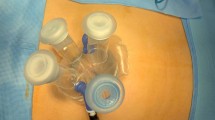Abstract
Introduction
Spigelian hernias (SH) are rare intraparietal abdominal wall hernias occurring just medial to the semilunar line. Several small series have reported on laparoscopic SH repair and both totally extraperitoneal (TEP) and transabdominal preperitoneal (TAPP) approaches have been described. However, there are limited outcome data including both of these techniques. We present the largest series to date of laparoscopic SH repair comparing both popular approaches.
Methods
Consecutive patients (n = 77) undergoing laparoscopic SH repair from 2009 to 2019 were identified from a prospectively managed quality database. All procedures were performed at a single institution. Patients were divided based on laparoscopic approach used, TEP group (n = 37) and TAPP group (n = 40). Comparison of patient demographics, surgical characteristics, and post-operative complications between TAPP and TEP groups was made using the Wilcoxon rank-sum and Fisher’s exact tests.
Results
Individuals undergoing TAPP had higher mean BMI (29.3 ± 5.4 vs. 26.3 ± 5.6 kg/m2; p = 0.019) and were more likely to have had prior abdominal surgery (65% vs 24.3%, (p < 0.001). Mean procedure length was 77 ± 45 min for TAPP repairs and 48 ± 21 for TEP repairs (p = 0.001). TAPP repairs had a significantly longer median LOS than TEP (25 vs. 7 h; p < 0.001). Days of narcotic use were significantly shorter after TEP repair than for TAPP (0 vs. 3; p = 0.007) and return to ADL was significantly shorter after TEP repair than for TAPP (5 vs. 7 days; p = 0.016. There were no significant differences in readmission, reoperations, SSI, or recurrence between the two groups.
Conclusion
Our large series revealed that both preperitoneal laparoscopic approaches, TEP, and TAPP, for SH repair are equally safe, effective, and can be performed on an outpatient basis. Therefore, we suggest that the approach used for repair should be based on surgeon experience, preference, and individual patient factors.




Similar content being viewed by others
References
Skandalakis PN, Zoras O, Skandalakis JE, Mirilas P (2006) Spigelian hernia: surgical anatomy, embryology, and technique of repair. Am Surg 72:42–48
Campanelli G, Pettinari D, Nicolosi FM, Avesani EC (2005) Spigelian hernia. Hernia 9:3–5
Webber V, Low C, Skipworth RJE, Kumar S, de Beaux AC, Tulloh B (2017) Contemporary thoughts on the management of Spigelian hernia. Hernia 21:355–361
Carter JE, Mizes C (1992) Laparoscopic diagnosis and repair of Spigelian hernia: Report of a case and technique. Am J Obstet Gynecol 167:77–78
Moreno-Egea A, Carrasco L, Girela E, Martín JG, Aguayo JL, Canteras M (2002) Open vs laparoscopic repair of spigelian hernia: a prospective randomized trial. Arch surg 137:1266–1268
Moreno-Egea A, Aguayo JL, Girela E (2002) Treatment of spigelian hernia using totally extraperitoneal laparoscopy ambulatory surgery. Surg Endosc 16:1806
Palanivelu C, Vijaykumar M, Jani KV, Rajan PS, Maheshkumaar GS, Rajapandian S (2006) Laparoscopic transabdominal preperitoneal repair of spigelian hernia. JSLS 10:193–198
Kelly ME, Courtney D, McDermott FD, Heeney A, Maguire D, Geoghegan JG, Winter DC (2015) Laparoscopic spigelian hernia repair: a series of 40 patients. Surg Laparosc Endosc Percutan Tech 25:e86–e89
Chan JW, Chiu PW, Ng EK (2008) Simultaneous laparoscopic totally extraperitoneal repair for concurrent ipsilateral Spigelian and indirect inguinal hernia. Surg Laparosc Endosc Percutan Tech 18:414–416
Law TT, Ng KK, Ng L, Wong KY (2018) Elective laparoscopic totally extraperitoneal repair for Spigelian hernia: a case series of four patients. Asian J Endosc Surg 11:244–247
Moreno-Egea A, Flores B, Girela E, Martín JG, Aguayo JL, Canteras M (2002) Spigelian hernia: bibliographical study and presentation of a series of 28 patients. Hernia 6:167–170
Fernandez-Moreno M, Marti-Cunat E, Pou G, Ortega J (2018) Intraperitoneal onlay mesh technique for Spigelian hernia in an outpatient and short-stay surgery unit: What's new in intraperitoneal meshes? J Lap Adv Surg Tech 28(6):700–704
Mittal T, Kumar V, Khullar R, Sharma A, Soni V, Baijal M, Chowbey PK (2008) Diagnosis and management of spigelian hernia: a review of literature and our experience. J Minim Access Surg 4:95–98
Barnes TG, McFaul C, Abdelrazeq AS (2014) Laparoscopic transabdominal preperitoneal repair of spigelian hernia-closure of the fascial defect is not necessary. J Laparoendosc Adv Surg Tech A 24:66–71
Patle NM, Tantia O, Sasmal PK, Khanna S, Sen B (2010) Laparoscopic repair of Spigelian hernia: our experience. J Laparoendosc Adv Surg Tech A 20:129–133
Moreno-Egea A, Campillo-Soto Á, Morales-Cuenca G (2015) Which should be the gold standard laparoscopic technique for handling Spigelian hernias? Surg Endosc 29:856–862
Barnes T, McWhinne D (2016) Laparoscopic Spigelian Hernia Repair: A Systematic Review. Surg Laparosc Endosc Percutan Tech 26:265–270
Acknowledgements
The authors would like to acknowledge the Grainger Foundation for salary support for a portion of the data collection.
Author information
Authors and Affiliations
Corresponding author
Ethics declarations
Disclosure
Dr. Michael Ujiki reports grants and personal fees from Boston Scientific, personal fees from Olympus, personal fees from Medtronic, grants and personal fees from Gore, outside the submitted work. Dr. John Linn reports teaching honoraria from R.L Gore and Dr. Stephen Haggerty reports personal fees from Medtronic, personal fees from RL Gore, travel expense from Intuitive, outside the submitted work.The authors Kara Donovan, Merritt Denham, Kristine Kuchta, JoAnn Carbray, and Dr. Woody Denham have no conflicts of interests or financial ties to disclose.
Additional information
Publisher's Note
Springer Nature remains neutral with regard to jurisdictional claims in published maps and institutional affiliations.
Rights and permissions
About this article
Cite this article
Donovan, K., Denham, M., Kuchta, K. et al. Laparoscopic totally extraperitoneal and transabdominal preperitoneal approaches are equally effective for spigelian hernia repair. Surg Endosc 35, 1827–1833 (2021). https://doi.org/10.1007/s00464-020-07582-9
Received:
Accepted:
Published:
Issue Date:
DOI: https://doi.org/10.1007/s00464-020-07582-9




